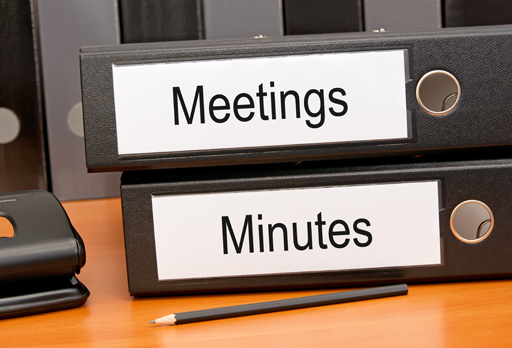6 Recording and following up meetings

There are a number of reasons for keeping a record of what goes on at meetings, such as:
- to record what was agreed and any actions that need to be taken
- to remind people of the actions they personally need to take as a result of the meeting
- to help settle any future disputes about what was agreed
- to inform others who were absent or have an interest in what was said or agreed at the meeting.
In a formal meeting it is the job of the secretary to write and keep the minutes. In more informal meetings someone may be asked to take on the task of taking the notes or minutes of the meeting.
When taking minutes, usually the most important things to record are any decisions and actions that need to be taken. In a formal meeting where voting takes place, it will be important to record accurately any proposals and resolutions and the results of voting. It can also be helpful to summarise the main discussion and arguments.
The minute-taker can play an important role in helping to clarify what has been agreed by checking back with the chair and other attendees if he or she is not clear. This can be helpful in avoiding later disputes and disagreements over what was decided. It is usual in formal meetings to record who was present and any apologies for non-attendance.
The style of minutes can vary from the abrupt (Example 1) to the chatty (Example 2).
Example 1
Volunteers’ regional conference. Verbal report received from delegates.
Example 2
Volunteers’ regional conference. Omar and Suzy reported back that the conference had been a great success. Many useful suggestions had been made about how to improve the volunteers’ newsletter, which they intend to take forward. Omar is to join a subgroup that has been set up to review and improve the training available to volunteers. Suzy will …
There is often a difficult judgement to be made over the amount of detail that is required. If minutes are too brief it may be difficult for those not at the meeting or those looking back later to make sense of what happened. However, if they are too detailed, people may miss the main points or be put off reading them.
One useful device is to have an actions column in the right-hand margin of the minutes or to use capital letters so the actions stand out. This can be used as well to note the name or initials of the person who has agreed to carry out the action. This can act as a reminder and make it easier for subsequent meetings to follow-up on whether the actions were taken. It is also useful for minutes to be received soon after the meeting so that actions can be followed up sooner rather than later.
